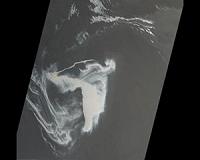| . |  |
. |
New Orleans, Louisiana (AFP) May 19, 2010 Oil from the Gulf of Mexico spill has entered a strong ocean current that will sweep it towards Florida and Cuba in days and possibly on up the Atlantic coast, experts warned Wednesday. The Loop Current has started dragging leaking crude from the giant slick off Louisiana towards Florida's popular tourist beaches and fragile coral reefs, threatening a whole new dimension to the unfolding environmental disaster. Scientists laid out a worst-case scenario in which the oceanic conveyor belt would see the first oil wash up in Florida in as little as six days, before carrying it up the US east coast and even into the Gulf Stream. The potential damage to the region's teeming and important marine life as well as fragile coastlines could be enormous, experts say. "The Loop Current is a super-highway carrying babies of a wide array of fishes and other kinds of marine life from their spawning zones to the places where they will ultimately grow up," Doug Rader, chief ocean scientist of the Environmental Defense Fund, told AFP. "This is the major organizing aquatic structure in the Gulf. Everything rides the Loop Current." Nearly a month after the Deepwater Horizon rig exploded on April 20 killing 11 workers, British energy giant BP has failed to stop the leak, although it says it has contained some 40 percent of the oil streaming from the wreckage. The European Space Agency said Wednesday its satellites showed oil being pulled into the powerful clockwise-moving current that joins the Gulf Stream, the northern hemisphere's most important ocean current system. "We have visible proof that at least oil from the surface of the water has reached the current," said Bertrand Chapron, a scientist at the French Research Institute for Exploitation of the Sea. The National Oceanic and Atmospheric Administration, the main US agency monitoring the spill, agreed a small portion of the slick had entered the current "in the form of light to very lightsheens." But it tried to temper fears saying the oil may never reach Florida and if it does it "would be highly weathered" and evaporation and chemical dispersants wouldhave "significantly" reduced the volume. "Oil entrained in the Loop Current would require persistent onshore windsor an eddy on the edge of the Loop Current for it to reach the Floridashoreline, NOAA said in its statement. But Radar told AFP it was "inevitable" that the cocktail of oil and chemical dispersants would eventually make it to Florida, to Cuba and into the Atlantic and up to beaches on the southeastern coast of the United States. "The probability of spill-based oil materials being delivered to Cuba and Florida and beyond is 100 percent," he predicted. Cuba's southwestern coast is home to one of the world's great coral and mangrove systems and to a nursery area that supports not just Cuban seafood, but also much of the rest of the western Caribbean. US officials said they have been keeping Havana up to date about the spill, and working level discussions took place Wednesday with Cuba's communist government even though the two countries do not have official ties. "We provided background related to the cause of the spill, stressed that stopping the oil leak is our top priority, and explained the projected movement of the spill," US State Department spokesman Gordon Duguid said. BP is continuing its efforts to siphon up as much of the oil as possible via a mile-long suction tube said to sucking up some 2,000 barrels of crude a day spouting from the fractured rig pipe. BP estimates that some 5,000 barrels, or 210,000 gallons, of crude is spewing each day from the wreckage of the Deepwater Horizon rig, although independent experts warn the flow rate could be 10 times higher. The British energy giant is preparing in the next week or so for a so-called "top kill" in which heavy drilling fluids are injected into the well to stem the oil flow, followed by a cement operation to seal it up permanently. Meanwhile, top US Senate Democrats urged President Barack Obama to order "immediate and enhanced inspections" of major offshore oil drilling work in US waters. "As the Gulf Coast continues to be threatened by the lasting effects of the Deepwater Horizon oil spill disaster, we are deeply concerned that this accident could be repeated elsewhere," they wrote to Obama.
Share This Article With Planet Earth
Related Links Our Polluted World and Cleaning It Up
 Underwater oil plumes could create new 'dead zone' in Gulf
Underwater oil plumes could create new 'dead zone' in GulfNew Orleans, Louisiana (AFP) May 17, 2010 Giant plumes of oil floating deep in the Gulf of Mexico could create a new 'dead zone' of oxygen-depleted waters unfit for marine life and wreak environmental damage that will take generations to overcome, scientists warned Monday. "Normally, in a shallow spill, everything pretty much shoots up to the surface and the impacts are primarily to surface organisms like turtles, dolphins, and bird ... read more |
|
| The content herein, unless otherwise known to be public domain, are Copyright 1995-2010 - SpaceDaily. AFP and UPI Wire Stories are copyright Agence France-Presse and United Press International. ESA Portal Reports are copyright European Space Agency. All NASA sourced material is public domain. Additional copyrights may apply in whole or part to other bona fide parties. Advertising does not imply endorsement,agreement or approval of any opinions, statements or information provided by SpaceDaily on any Web page published or hosted by SpaceDaily. Privacy Statement |